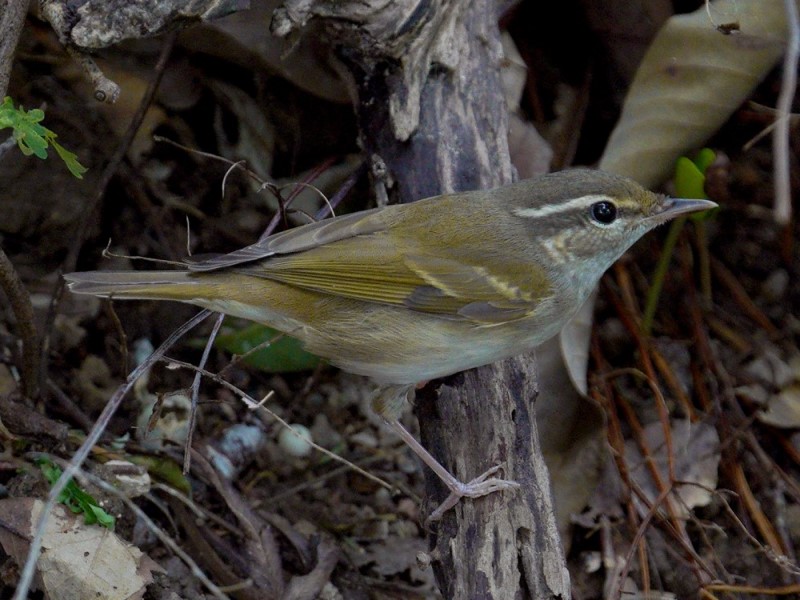Sakhalin Leaf Warbler Phylloscopus borealoides 庫頁島柳鶯
Category I. Scarce passage migrant in autumn, with single confirmed records in winter and spring; occurs mainly in closed-canopy woodland and shrubland.
IDENTIFICATION

Oct. 2021, Roman Lo.
10-11 cm. Relatively short-billed and brownish-tinged leaf warbler with darker and greyer crown and eye-stripe, pale wing bars and pale pinkish legs. Often has an obvious pale tip to the bill. The supercilium is broader than that of Arctic Warbler, often broadest above the eye and kinks upward at the rear when the body and head are aligned horizontally. The ear coverts are pale, meaning the eye-stripe is prominent. The underparts are whiter than those of Arctic Warbler and the undertail coverts can rarely be very faint yellow (Leader 1993). Apparently indistinguishable from Pale-legged Leaf Warbler on plumage but may have a slightly longer primary projection. Habitual tail-dipping also distinguishes it from other Phylloscopus warblers in HK.
VOCALISATIONS
The vocalisations are critical in field identification. The usual call is a single moderately high-pitched, sharp ‘tee, ‘tsee’ or ‘tip’ at a frequency of 4.52-5.25 kHz (Hungnon et al. 2017), which is approximately the pitch of the pure, whistled call note of Siberian Rubythroat. With experience, the call of many birds is distinguishable from the call of Pale-legged Leaf Warbler, which is 0.25 kHz to 1.4 kHz higher in pitch. Occasionally Sakhalin Leaf Warbler utters several high-pitched introductory notes, but usually it soon settles into the more typical call.
The song is jaunty phrase usually consisting of three notes, all at different pitch, uttered in groups of 2-4.
DISTRIBUTION & HABITAT PREFERENCE
Sakhalin Leaf Warbler occurs in widespread areas where suitable wooded cover for migrants exists, but particularly in woodland and closed-canopy shrubland. There appears to be no difference in habitat preference from Pale-legged Leaf Warbler. Since an understanding of the difference in call from Pale-legged Leaf Warbler, it has proved to be annual, though in somewhat variable numbers. For example, there was only one record in 2019, but approximately 20 in 2020.
OCCURRENCE
Sakhalin Leaf Warbler is almost exclusively an autumn passage migrant (Figure 1), with substantiated records occurring mainly in the period 8 September to 12 November. The number of records is as yet insufficient to allow more detail to be described, though main passage is probably the first three weeks of October, slightly later than that of Pale-legged Leaf Warbler. There are two late autumn/early winter records on 22nd and 26 November and one record of a wintering bird on 25 December 2016. There are two spring records, on 4th and 15 April.
BEHAVIOUR, FORAGING & DIET
Generally forages in shrub or shrub understorey in the lower layer of the forest, but also occurs in densely vegetated parts of some urban parks. Has not been reported in song in HK.
RANGE & SYSTEMATICS
Monotypic. Breeds from Sakhalin south through the Kuril Islands to Hokkaido and Honshu. The non-breeding season distribution is now understood to be the south China coast (rare) and Hainan south through much of mainland southeast Asia to Singapore (Clement and de Juana 2020), and therefore probably also north Sumatra.
CONSERVATION STATUS
IUCN: Least Concern. Population trend decreasing.
Figure 1.

Clement, P. and E. de Juana (2020). Sakhalin Leaf Warbler (Phylloscopus borealoides), version 1.0. In Birds of the World (J. del Hoyo, A. Elliott, J. Sargatal, D. A. Christie, and E. de Juana, Editors). Cornell Lab of Ornithology, Ithaca, NY, USA. https://doi.org/10.2173/bow.salwar1.01
Hungnon, C., J. Khudamrongsawat, S. Manawattana, A. J. Pierce and P. D. Round (2017). Distinguishing between Sakhalin Leaf Warbler Phylloscopus borealoides and Pale-legged Leaf Warbler P. tenellipes on call. Forktail 33 (2017): 77-80.
Leader, P. J. (1993). The field identification of Arctic, Eastern Crowned, Two-barred Greenish and Pale-legged Leaf Warbler in Hong Kong. Hong Kong Bird Report 1992: 153-159.

